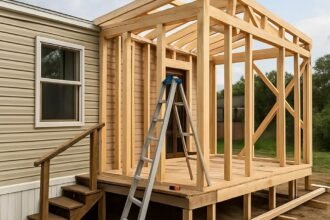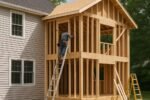When it comes to financing your home addition in 2025, you have several options at your disposal. Understanding your home equity is essential, as it can serve as a significant resource. Personal loans and Home Equity Lines of Credit (HELOC) also offer viable paths, but they come with their own set of pros and cons. Before making a decision, you’ll want to take into account all avenues available to you for a smooth financing experience. What’s the best choice for your project?
Key Takeaways
- Assess your home equity to determine if tapping into it for financing is a viable option for your home addition project.
- Explore personal loans for fixed interest rates and predictable payments, ensuring they align with your budget and financial situation.
- Consider a Home Equity Line of Credit (HELOC) for flexible borrowing, but be mindful of fluctuating interest rates and repayment risks.
- Evaluate cash-out refinancing by comparing current mortgage rates and understanding closing costs to maximize available funds for your addition.
- Research government programs, grants, and subsidies that may provide financial assistance for home additions based on eligibility criteria and application processes.
Understanding Your Home Equity
When you’re considering a home addition, understanding your home equity is essential, as it can greatly influence your financing options.
Your home equity represents the difference between your home value and the outstanding mortgage balance. By tapping into this equity, you can access equity loans, which typically offer lower interest rates compared to personal loans.
Evaluating your home value accurately guarantees you know how much equity you can leverage. If your home has appreciated, you may find yourself in a strong position to finance your addition.
This understanding allows you to make informed decisions about your project and budget effectively.
Exploring Personal Loans
While you may have equity in your home, personal loans can serve as a viable alternative for financing a home addition. Understanding the various personal loan types is essential for making an informed decision. These loans typically offer fixed interest rates and predictable loan repayment terms, making budgeting easier.
| Personal Loan Type | Interest Rate Range | Loan Term |
|---|---|---|
| Unsecured Loans | 5% – 36% | 3 – 5 years |
| Secured Loans | 3% – 15% | 1 – 7 years |
| Co-signed Loans | 6% – 20% | 2 – 6 years |
| Peer-to-Peer Loans | 6% – 30% | 3 – 5 years |
Evaluating these options helps you find the best fit for your financial situation.
Utilizing Home Equity Lines of Credit (HELOC)
A Home Equity Line of Credit (HELOC) can be an effective way to finance your home addition, leveraging the equity you’ve built in your property.
One of the primary HELOC benefits is flexibility; you can borrow as needed and only pay interest on the amount used. Additionally, interest rates are often lower than personal loans.
One key advantage of a HELOC is its flexibility, allowing you to borrow only what you need and pay interest solely on that amount.
However, it’s essential to evaluate HELOC risks, such as fluctuating interest rates that can increase your repayment costs. Furthermore, if you default, you risk losing your home.
Weigh these factors carefully to determine if a HELOC aligns with your financial goals and circumstances.
Considering Cash-Out Refinancing
Cash-out refinancing offers another viable option for financing your home addition by tapping into your home’s equity. This strategy allows you to replace your existing mortgage with a larger one, giving you cash to fund your project.
Here are four key factors to evaluate:
- Equity Amount: Assess how much equity you have in your home.
- Interest Rates: Compare current rates to find favorable refinancing options.
- Closing Costs: Calculate potential fees involved in the refinancing process.
- Loan Terms: Review different loan terms to choose the best cash-out strategies for your needs.
Investigating Government Programs and Grants
When considering financing for your home addition, it’s important to explore available government programs and grants that may ease your financial burden.
These resources can offer significant assistance, but understanding the application process is vital for maximizing your chances of approval.
Available Government Programs
Exploring available government programs and grants can greatly ease the financial burden of a home addition. Here are some options to evaluate:
- Federal Subsidies: These can reduce your overall costs and make renovations more affordable.
- State Incentives: Many states offer tax credits or rebates for energy-efficient home improvements.
- Local Grants: Some municipal programs provide funding for specific types of home upgrades.
- Low-Interest Loans: Government-backed loans can help you finance your addition at a lower rate.
Researching these opportunities can help you maximize your budget and achieve your home improvement goals.
Grant Application Process
Securing funding for your home addition often involves maneuvering the grant application process.
First, familiarize yourself with the grant eligibility criteria, which can vary by program. These criteria often include income limits, project type, and location.
Next, be aware of the application timeline; deadlines can be strict and vary greatly between grants. Prepare your documentation ahead of time, ensuring you meet all requirements.
Additionally, consider reaching out to local agencies for assistance and clarification.
Budgeting for Your Home Addition
When budgeting for your home addition, it’s essential to assess all project costs accurately.
Setting a realistic budget helps guarantee you can cover expenses without financial strain.
Additionally, incorporating a contingency fund can safeguard against unexpected costs that often arise during construction.
Assessing Project Costs
To effectively budget for your home addition, it’s essential to start by evaluating all potential project costs.
A thorough cost breakdown will help you understand your financial commitments.
Consider these key factors:
- Materials: Assess the quality and quantity needed.
- Labor: Factor in contractor fees and worker wages.
- Permits: Research local regulations and associated fees.
- Contingency: Allocate funds for unexpected expenses.
Setting a Realistic Budget
Once you’ve assessed the project costs, it’s time to set a realistic budget that aligns with your financial situation and goals.
Begin with a detailed cost breakdown of materials, labor, and any permits required. This clarity helps you understand where your money goes.
Implement expense tracking to monitor your spending throughout the project, ensuring you stay within your budget. Adjust your expectations if necessary, prioritizing essential features over luxuries.
By being disciplined with your budget, you’ll avoid financial strain and create a sustainable plan for your home addition.
Contingency Fund Importance
A contingency fund is essential for any home addition project, as unexpected expenses often arise despite careful planning. Having a financial cushion can greatly ease the stress of unforeseen costs.
Consider these key aspects of contingency planning:
- Percentage of Budget: Aim for 10-20% of your total budget.
- Common Surprises: Factor in potential issues like structural problems or permit delays.
- Flexibility: Use your fund to adapt to new design ideas or necessary changes.
- Peace of Mind: A contingency fund guarantees you can proceed confidently, knowing you’re prepared for the unexpected.
Finding the Right Contractor and Project Estimates
Finding the right contractor and obtaining accurate project estimates are essential steps in guaranteeing your home addition is completed on time and within budget.
Start by evaluating contractor qualifications, including experience and references. A qualified contractor should provide detailed project timelines, helping you understand the duration of each phase.
Request estimates from multiple contractors to compare costs and services. Confirm these estimates include all necessary materials and labor, preventing unexpected expenses down the line.
Conclusion
Financing your home addition in 2025 requires careful consideration of your options. By understanding your home equity, exploring personal loans and HELOCs, and investigating government programs, you can find the best solution for your needs. Budgeting effectively and securing accurate project estimates will help you manage costs. Ultimately, thorough research and planning will empower you to make informed decisions, ensuring your home enhancement project is both financially feasible and aligned with your vision.








